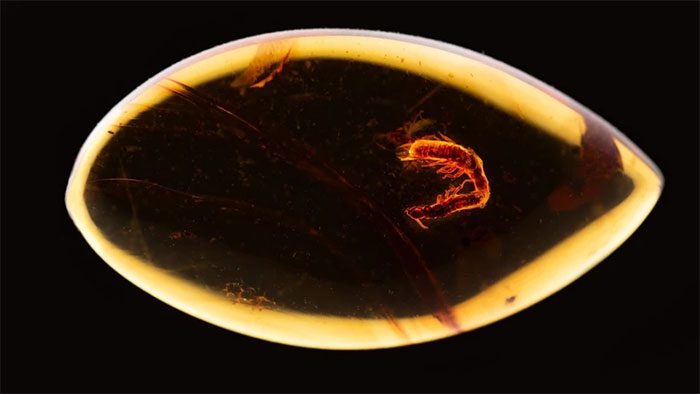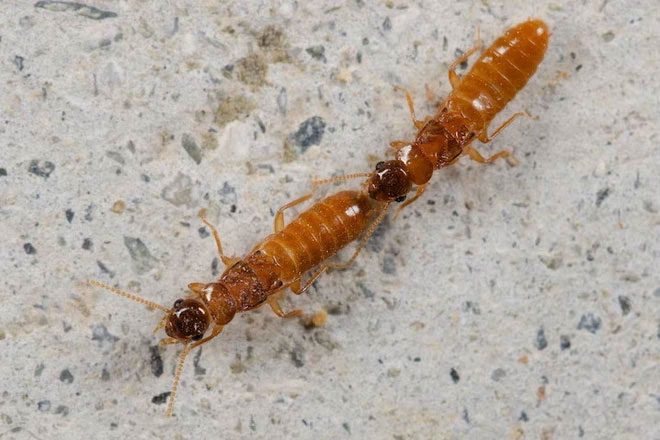A couple of termites trapped in tree resin while preparing to mate 38 million years ago has revealed valuable information about the mating behavior of this extinct insect species.
Researchers from the Czech Republic and Japan were puzzled when they discovered a pair of extinct Electrotermes affinis termites preserved in a 38-million-year-old piece of amber in a strange mating position, rather than the typical position seen in modern termites where one is behind the other.

Two termites preparing to mate preserved in amber 38 million years ago. (Source: Dr. Aleš Buček/Czech Academy of Sciences).
The Okinawa Institute of Science and Technology in Japan reported that Aleš Buček, head of the Insect Symbiosis Laboratory at the Czech Academy of Sciences and co-author of the study, discovered and purchased this rare piece of amber through an online platform specializing in fossils.
Researchers were intrigued by the unusual mating position of the Electrotermes affinis termites, which contrasts with the typical behavior of modern termites.
Buček stated: “Termite fossils are quite common, but this amber piece is unique. I have seen hundreds of amber pieces preserving termites, but I have never encountered a case with a pair like this.”
This fossil is a 38-million-year-old Baltic Eocene amber, discovered from a mine in Yantarny, Kaliningrad, Russia.
Bubbles in the amber obscured the rear abdomen of the termite pair, so researchers from the Okinawa Institute of Science and Technology utilized 3D X-ray micro-imaging techniques to get a clearer view, confirming that one was male and the other female.
The two termites were preserved side by side, with the female’s mouth touching the male’s abdomen.

Close-up image shows the position of the two termites, with the female’s mouth (left) touching the male’s abdomen. (Source: Dr. Aleš Buček/Czech Academy of Sciences)
This close contact of the abdomen is part of a common mating behavior in termites called “parallel running,” which occurs when the following individual clings tightly to the preceding individual’s abdomen in a straight line, resembling a train of cars.
Mating pairs of termites typically maintain this position while searching for nesting sites. Therefore, the side-by-side position of this fossilized pair is unusual for the species’ mating behavior.
To investigate whether ancient termites might have changed position when trapped in tree resin, the research team attempted to recreate the final moments of this couple in the lab using live termites.
Researchers at the Okinawa Institute of Science and Technology arranged Formosan subterranean termites (Coptotermes formosanus) to walk on a sticky surface simulating tree resin while preparing to mate.
In the experiment, many termites escaped from the sticky trap. For those that became stuck, their partners did not flee but continued to move around and eventually also got caught in the sticky surface in a position remarkably similar to the fossilized pair.
This suggests that ancient termites likely also “ran parallel” in a straight line before becoming enveloped by tree resin.
The researchers concluded that modern termites exhibit mating behaviors very similar to their ancestors tens of millions of years ago.

A pair of Formosan subterranean termites in a “parallel running” position as they prepare to mate. (Source: Dr. Aleš Buček/Czech Academy of Sciences).
Nobuaki Mizumoto, Assistant Professor of Entomology and Plant Pathology at Auburn University in Alabama, USA, stated: “If a pair of termites encounters a predator, they typically look for ways to escape, but on a sticky surface, they do not recognize the danger and get trapped.”
He also emphasized that the existence of this amber fossil has shocked the scientific community, providing a unique opportunity to analyze the mating behavior of an extinct insect species.


















































